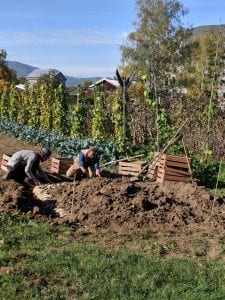“Is organic food really better for the environment?” That was the title of a recent blog post recent blog by Anuradha Varanasi writing for Columbia University’s Earth Institute. This is a great question, and it refers to a study reported on in Nature in 2018 (See original article).
Dozens of commentaries have been published since, for example, here organics commentary, in part, because the findings were controversial: organic farming has a greater climate impact since yields are generally lower and more land is required to compensate for the lower yields. Apparently, part of the issue is the lack of concentrated sources of nutrients (aka industrial fertilizes) available to organic growers.
Ideas around organic farming and its (sometimes) lower yields, its need for more land area, and its challenges in fertility sources has been around for a long time. What is new is the method that the researchers used to assess climate impact from varying land uses, including crops (peas, Swedish small grains) using a “carbon benefits index” that gives some indication of the global capacity to store carbon and reduce total greenhouse emissions. Crop agriculture was just one of the land uses studied.
The researchers offer some really interesting ways to “account” regarding carbon storage and carbon storage opportunity costs. The question the researchers raise are important—which changes in production and consumption would produce more carbon benefits? The findings are a little startling– increasing crop inputs usually saves more greenhouse gas emissions through reduced land demands.
But let’s have a FoodWISE moment—stop, think, then act. The narrative is powerful, and it’s one that ends in decrying deforestation (clearing land to make room for more rows of organic peas) and more. Who are the winners and who are the losers in this argument? What’s missing in it?
Well, to start, the index does not measure biodiversity or the value of other ecosystem functions (which the authors admit) with the different land uses and practices, and these certainly need to be part of the equation. Questions also abound regarding how efficiency is measured, and the researchers, themselves, note the “uncertainties and certain data advantages of [their] approach.”
A FoodWISE approach looks at challenges to and for organics, and it’s not difficult to see that there are quite a few. The soil-crop nutrients-water mix that needs to happen for optimal crop agriculture is something we need to pay attention to—and scale of production (and relative labor inputs) is going to be a big part of the discussion. But that’s another topic, and it doesn’t take away from the good work and thoughtful commentary on the research published in Nature, which serves as a starting point for healthy discussion.
